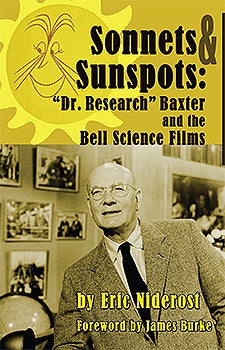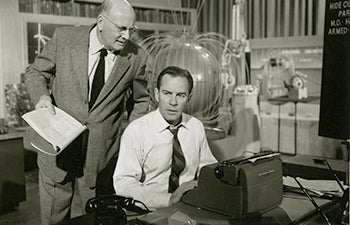
Hats Off to Dr. Research
Frank Baxter was one of the most popular and genuinely charismatic professors ever to teach at USC. The bald, bespectacled Baxter, a professor of English literature, had such a great reputation that the Daily Trojan once opined that if you didn’t take Baxter, “you haven’t been to college.”
His annual Christmas readings at Bovard Auditorium were so popular that one year, there wasn’t even standing room. Instead, students clustered around loudspeakers outside in the rain, clutching their umbrellas as they took in every word.
But the professor also contributed to educational television in its fledgling state. Before Baxter, the medium seemed to be struggling just to survive. National Educational Television (NET) was born in 1952, a network that would become the Public Broadcasting Service (PBS) in 1970. It was a decidedly inauspicious debut. Most of the programing was done in actual classrooms, showcasing nervous pedagogues, chalk in hand, scribbling words of wisdom on blackboards while sweating under the searing heat of early television lights. The overall impression was underwhelming and hardly inspirational.

Sonnets & Sunspots: “Dr. Research” Baxter and the Bell Science Films, was published by BearManor Media in May 2014.
This all changed with Baxter. It can be argued that he, and he alone, was responsible for making educational TV a popular venue for learning. There were other pioneers but no one came close to having the universal impact that Baxter had on the American public from 1953 to 1970. A born teacher, his infectious love of learning, wide range of interests and charismatic personality overcame the meager budgets and technical drawbacks of those early years.
Baxter debuted on TV in 1953, the same year classic sitcoms like I Love Lucy ruled the airwaves. A Los Angeles TV station featured Baxter in a series called Shakespeare on TV. It was a huge hit, and eventually took the country by storm. Before long Baxter had garnered two Emmys for his work and began starring in other small-screen educational programs. By the end of his career he would win a total of seven Emmys and the first Golden Gavel Award.
In the late 1950s and early 1960s, he was everywhere on the video dial, hosting dramas, making guest appearances in sitcoms and even trading comedic barbs on variety shows. Baxter’s status as America’s favorite academic reached new heights when he starred in a series of popular science programs sponsored by Bell Telephone. Originally airing on TV, shows such as Our Mr. Sun (1956) and Hemo the Magnificent (1957) enjoyed a whole new life when transferred to 16mm film and distributed to schools throughout the country.
Baxter not only single-handedly put educational television on the map, but became a cherished and indelible memory in the minds of countless baby boomers. His trailblazing Shakespeare series is the “ancestor” of online classes and telecourses offered in colleges and universities today.
Francis Condie Baxter was born on May 4, 1896, in Newbold, New Jersey. He became an accountant as a young man, but soon joined the army to serve in France during World War I. He emerged from the war unscathed, save for the lasting legacy of a wooden case of salmon that fell on his foot. With typical humor, he said, “It gives me a picturesque limp on rainy days.”
After the war he went to college and eventually obtained his Ph.D. from Cambridge University in England. He started teaching at USC in 1930. Baxter was noted for making any subject he taught interesting and exciting. His lively lectures were augmented by various models he brought into the classroom. Probably the most famous of these was Shakespeare’s Globe Theatre, a model he made himself.
The first four Bell Science films were produced and directed by the legendary director Frank Capra, perhaps best known for the perennial Christmas favorite It’s a Wonderful Life. Warner Brothers then took over the series, producing Gateways to the Mind, The Alphabet Conspiracy, The Thread of Life and About Time. All used Baxter’s services.

Frank Baxter with actor Richard Carlson in The Strange Case of the Cosmic Rays, a 1957 TV movie. (Photo Courtesy: Wesleyan Cinema Archives.)
As his fame grew, he was a frequent guest on television shows and even tried his hand at acting. Baxter appeared on the Tennessee Ernie Ford Show in 1957, participating in a series of humorous skits. In the plot, Baxter wants to go into “real show business” by playing the bongo drums. He also essayed the role of “Dr. Gagan,” an industrialist giving out a scholarship, in the 1963 high school drama Mr. Novak.
Although Baxter retired in 1961, he kept quite busy in films, acting and lecturing throughout the country. He died in 1982 at age 85, honored as one of USC’s greatest educators.
Eric Niderost is an instructor of history at Chabot College in Hayward, California. A freelance author, he has published nearly 300 articles on American and European history. His most recent book, Sonnets & Sunspots: “Dr. Research” Baxter and the Bell Science Films, was published by BearManor Media on May 23.